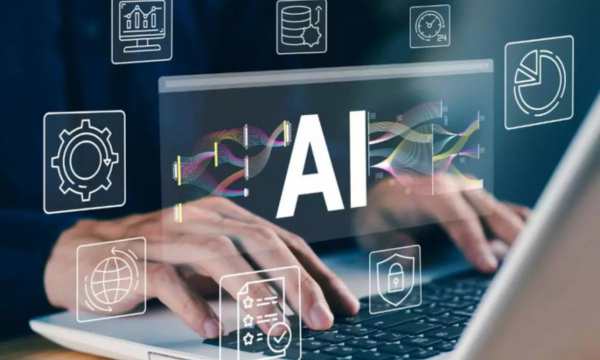Adding artificial intelligence (AI) technology to cybersecurity is a significant change in the way digital defense works.
Ad
It promises to make security smarter, faster, and more effective than ever before. This change is more than an improvement; This is a revolution that will change the way digital assets and systems are protected.
This article describes the various applications of artificial intelligence in defense, including their advantages and disadvantages, and how this combination may develop in the future.
The Emergence of AI in Cybersecurity
At its core, cybersecurity is about protecting computer systems, networks, and data from threats, compromises, and people who shouldn’t be there. Traditional security methods can no longer keep up with changes in cyber threats.
This is where artificial intelligence comes into play, giving us the tools to learn and change faster than humans can in response to new risks.
Machine Learning (ML), Natural Language Processing (NLP), and Deep Learning are some of the AI technologies that are playing a very important role in this transformation.
These technologies make it possible to create systems that can search for threats through large amounts of data, guess where weaknesses lie, and automatically set how to respond to them.
Purpose and benefits
Better detect and respond to threats
AI-driven systems can look at very large data sets to find trends and outliers that could indicate cyber threats, such as malware, phishing, or even ransomware.
Traditional systems rely on rules and signatures that are already set up. AI models, on the other hand, continually learn and update what they know, allowing them to quickly spot new threats as they change.
Predictive analytics
AI tools use predictive analytics to guess what threats will arise in the future by looking at past data and current trends.
With this approach, companies can prepare for and protect themselves against potential vulnerabilities before they are exploited.
Automate and save time
Artificial intelligence improves cybersecurity by taking over tedious tasks such as monitoring network traffic or keeping security protocols up to date.
This not only speeds up response times but also frees up staff to work on more difficult security issues.
Challenges and Considerations
Complexity and putting it into practice
Applying artificial intelligence to cybersecurity requires a lot of knowledge and financing. Artificial intelligence systems can be difficult to use because they are complex and require large amounts of training data. This is especially true for small businesses.
Threat of change
As defenses against cyber attacks change, so do hacking methods. Bad actors can use AI technology to launch smarter and more dangerous attacks, creating an ongoing arms race between attackers and defenders.
Concerns about ethics and privacy
When artificial intelligence is used in hacking, it raises ethical questions, especially when it comes to privacy.
AI-driven security requires analyzing large amounts of data, which, if not processed properly, could violate people’s privacy rights.
The Future of AI in Cybersecurity
The future of artificial intelligence in defense looks bright but should be approached with caution. As AI technology continues to evolve, we will be better able to detect, predict, and stop threats.
But this future will also require a concerted effort to address the problems these technologies pose, such as their potential for abuse and the need for strong regulatory systems.
Collaborating with AI
Collaborative AI systems that can share insights and lessons learned across organizations and industries could be the next big step in AI-driven conservation.
Using this collaborative approach can make it easier to combat advanced cyber threats around the world.
Easy to understand AI (XAI)
As artificial intelligence models become more complex, it is more important than ever to understand how they make decisions (XAI).
This is important to gain trust in AI systems and ensure that they are used responsibly and ethically in the event of a hack.
Better threat intelligence
Artificial intelligence will continue to push the boundaries of threat intelligence, making it possible to build more advanced systems that can predict threats more accurately and provide more detailed information about potential vulnerabilities.
Conclusion
Adding artificial intelligence to cybersecurity is a big step toward making digital defense smarter, more efficient, and more flexible.
This combination has many benefits, but some issues need to be addressed to reach its full potential. Moving forward, we must ensure that AI is used intelligently, and as our digital defenses evolve, they do so in a way that is safe, ethical, and beneficial to all.
The use of artificial intelligence in cybersecurity is just beginning, but the path points to a future where digital security is stronger, smarter, and able to keep pace with ever-changing threats.
FAQs
1. What is artificial intelligence in security?
When it comes to cybersecurity, artificial intelligence or AI refers to the use of machine learning algorithms and data analytics to detect risks and anomalies, predict attacks before they happen, and automate response strategies to make organizations more secure.
2. In what ways does AI improve security?
Artificial intelligence improves security by automatically discovering and addressing threats in real-time.
It can look at large amounts of data to look for patterns and guess what threats might arise. This significantly reduces response time and the chance of human error.
3. What are the applications of artificial intelligence in network security?
Some examples include systems that look for strange behavior, automated security systems that detect and block threats without human assistance, and artificial intelligence platforms that provide up-to-date details about emerging threats.
4. Do you know the risks associated with using artificial intelligence in cybersecurity?
Artificial intelligence can make cybersecurity more robust, but it also poses risks, such as the possibility that AI systems can be hacked to bypass security measures, the possibility of false positives, and ethical concerns about privacy and surveillance.
5. How can artificial intelligence help detect hacking attempts?
Artificial intelligence (AI) systems can look at the text and metadata of emails to spot patterns that are common in phishing campaigns.
This can include looking at images from senders, finding malicious links or attachments, and noticing language patterns that are intended to deceive.
6. Can AI block ransomware attempts?
AI can help stop ransomware attacks by finding and blocking ransomware payloads before they run, looking at behavioral patterns to guess what the ransomware will do, and automatically quarantining affected systems to prevent ransomware from spreading.


